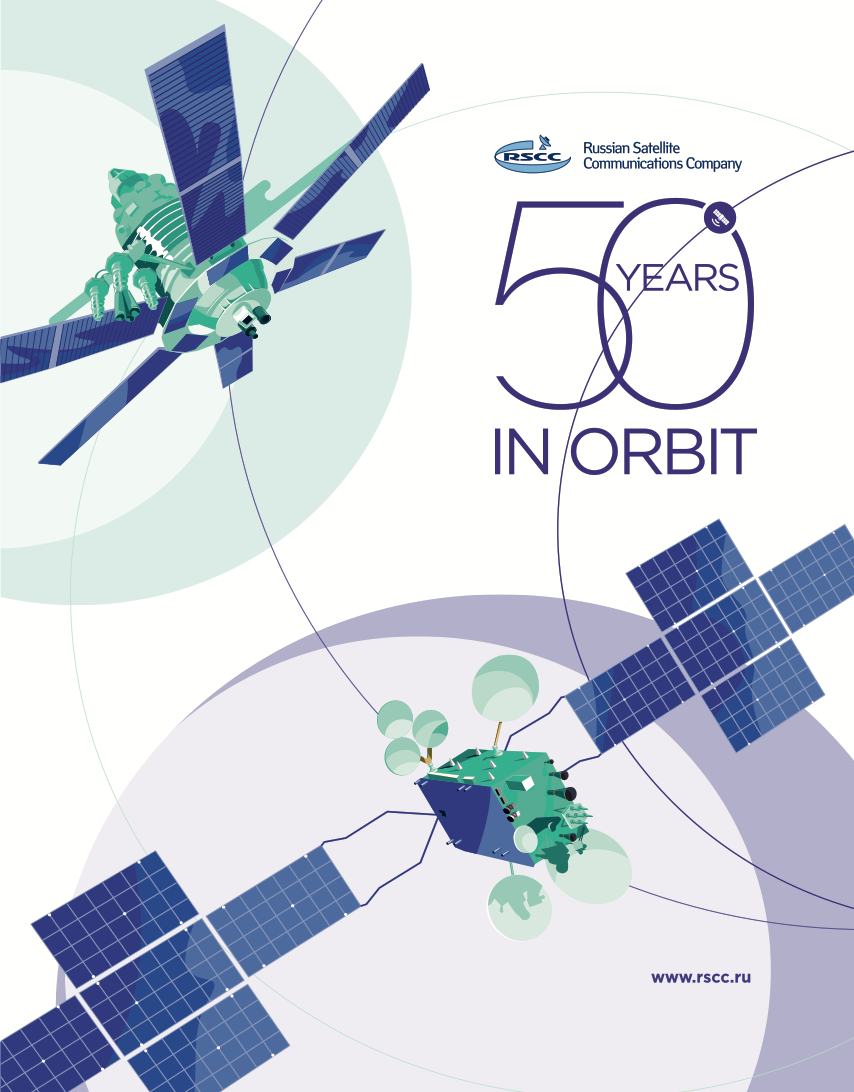GeoSync Microwave—The First Decade and the Best Year Yet
By Arthur Faverio, President and Chief Executive Officer, GeoSync Microwave
This coming February, GeoSync will have completed their tenth year in business — and, the past year has also been the firm’s best year yet experienced.

GeoSync Microwave’s new 20,000 square foot building, Hauppauge, New York.
Measured from a business point-of-view, as well as by the number of new, innovative products the company introduced, 2017 was the finest performance year of GeoSync Microwave’s first decade.
At the start of 2017, the company acquired a modern, 20,000 square foot building in Hauppauge, New York. The new building houses an advanced engineering design lab, test, manufacturing plant, and will also accommodate
future growth.
The facility was immediately put to good use and was the home to many new product releases including; wide band (17.2 to 22.2 GHz and 27.0 to 31.0 GHz) Block Up and Down Converters, multi-octave bandwidth Frequency Synthesizers with exceptionally low close in phase noise, phase stabilized wide band Frequency Converters with step sizes as small as 1Hz, multi-band Test Translators, multi-channel Up-link Power Controllers, Q-band Block Up and Down converters, and more.
An advancement in wide bandwidth frequency converters is the instantaneous 4 GHz bandwidth
Ka-band converter design that eliminates the use of separate converter modules and the associate power combiner and cabling losses.
By doing so and by through the use of a completely integrated design, along with GeoSync’s low phase noise synthesizer technology, superior phase linearity, and low phase noise, frequency flatness is achieved.
Another significant step is a K-band block down converter with an electronically Phase Stabilized 20 GHz Oscillator that achieves less than 5 degrees phase shift per degrees C change over an ambient temperature range of 10 degrees C
to 40 degrees C.
For narrower, selectable band needs, GeoSync introduced the DBFEN series of outdoor K-band Block down converters, where the letter N in the model number designates either Tri (3), Quad (4),or Quint (5) bands, with each band being either 500 MHz or 1 GHz wide over the range 17.3 GHz to 20.2 GHz.
Additionally, C- and Ku-band models are available in similar configurations.
The new GeoSync BTM series of Uplink power control systems control up to three Tx channels over a 20 dB range in 0.2 dB steps by monitoring one or two beacon receivers.
Control at either an IF bands of 70/140MHz, or L-band of 950 to 2150 MHz, is provided. Custom versions are available that can manage the uplink power control requirements for as many as 16 independent Tx channels.
The GFS-500M6 Frequency Synthesizer that covers from 500 MHz to 6.0 GHz was the first of a series of Frequency Synthesizers with an exceptionally low close in phase noise specification and superior integrated phase noise.
For example, at 500 MHz and an offset of just 1 Hz, the phase noise is -84 dBc/Hz and at t 6 GHz and a 1 Hz offset from the carrier, the phase noise is -55 dBc/Hz. The integrated phase noise from 1Hz to 100 MHz is ≤ 0.50 degrees. The models have two independent programmable outputs and can be adjusted to have steps from 1Hz to
100 kHz.

Other frequency bands, multi-octave to decade spans, are available with custom frequency synthesizers up to Q-band frequencies.
The UBR-44.5/48 is a Q-band block up converter cover in two bands the frequency range of 43.5 GHz to 48.0 GHz with a sister product being the DBR-38 converting the 37.5 GHz to 38.5 GHz band to an L-band IF.
Both units have superior low phase noise, intermodulation distortion, gain flatness and frequency characteristics. Either outdoor or rack mount models are available.
Special versions of indoor and outdoor test translators were developed over the past year.
Multi-band models include tri, quad, and up to 11 bands covering all standard and unique SATCOM frequency bands from L- to Ka-band.

GeoSync Microwave’s Frequency Band Rack Mounted Block Converter for SATCOM.
Mid-year, GeoSync Microwave introduced a new series of S-band Dual Conversion Synthesized Frequency Converters that cover the standard RF band of 2.0 to 2.4 GHz with an IF frequency of 70 MHz or a 140 MHz option.
Standard model converters can be tuned over the band in 1 kHz steps. Custom step sizes as small as 0.1 Hz over narrower bands of interest are available as an option.
The converters use GeoSync’s proprietary frequency synthesizer designs as the LOs which permits flexibility in meeting special band requirements.
Typical phase noise over the full band is -90 dBc/Hz at 1 kHz offset. Custom models covering narrower band easily achieve -100 dBc/Hz at a 1 kHz offset.
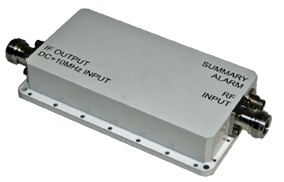
GeoSync Microwave’s Block Downconverter Receive Band to L-Band designed to provide downconversion from the satellite transponder to L-band.
If required, alternative IF frequencies to the standard IF frequencies of 70 or 140 MHz can be provided.
The upconverter gain of 32 dB typical is adjustable over 30 dB in 0.2 dB steps. Also, the nominal downconverter gain of 46 dB is adjustable over a 30 dB range in 0.2 dB steps.
Control is via 10/100Base-T Ethernet or serial RS422/RS485. Complete specifications can be found in GeoSync’s GS-1SPC data sheet. The upconverter model number is UTR-200240 and the downconverter model number is
DTR-200240.
Since the company’s start in 2008, GeoSync Microwave principal strategy has been — and continues to be — to give customers superior solutions to their RF SATCOM needs.
Many of the products listed above are solutions to such challenges and they are a partial indication of GeoSync’s capabilities.
Starting the second decade of business at the start of the new year, GeoSync Microwave will continue to focus on superior engineering and the expansion of the firm’s capabilities while opening new markets over the next decade.
geosyncmicrowave.com/
Gilat Satellite Networks—A Remarkable 2017
By Doreet Oren, Director of Product Marketing and Corporate Communications, Gilat Satellite Networks
For Gilat Satellite Networks, 2017 has been a most remarkable year, as the company brought to market innovative solutions that addressed the hottest market trends — two such notable trends are: In-Flight Connectivity (IFC) and Cellular Backhauling (CBH) over satellite.

Connectivity Cravings in the Air
The promise of In-flight Connectivity (IFC) is here as a growing number of commercial airlines offer broadband to their passengers. In a recently published research report, Euroconsult estimated that nearly 50 percent of commercial aircraft will be connected by 2021.
The increasing number of airplanes with internet connectivity is not surprising, given the user demand and recent technological advancements. For those who are used to being connected round the clock, having internet access between take-off and landing is more important than being served an in-flight meal. Research shows that connectivity is preferred over food and often a passenger’s selection of an airline is affected by whether or not Wi-Fi is available during flight.
Gogo 2Ku Service Empowered by Gilat’s Aero Modem
During 2017, Gilat has significantly contributed to the IFC market with a broad portfolio of solutions. Gogo has upgraded their IFC service with Gilat’s next-generation aero modem. Passengers using 2Ku service experienced an enhanced user experience, due to the modem’s high throughput.
In November, Gogo reached an important milestone as 150 airplanes belonging to four different airlines are now flying with Gilat’s aero modem. Gogo continues to ramp up their 2Ku service, which is planned to cover approximately 2,000 aircraft serving 13 airlines.
To support the planned expansion, Gilat’s baseband equipment is being deployed worldwide in one of the world’s largest IFC networks, which is expected to utilize bandwidth capacity from more than 20 satellites. Gilat’s global reach coupled with local expertise is supporting the installation of the ground segment equipment in multiple locations around the globe.

As the plane travels along its route, Gilat’s IFC solution uses advanced algorithms for beam selection, ensuring transparent switchover between beams, satellites and gateways, while maintaining user application sessions. This provides for seamless coverage regardless of the plane’s location, enabling passengers to enjoy the highest quality experience throughout their journey.
Gilat’s distributed X-Architecture is at the heart of this massive deployment. The scalable hub platform is uniquely suited to support global mobility across multiple satellites and beams. Its TotalNMS management system lets IFC service providers manage their services independent of the satellite operator, including real-time location and status monitoring for all airborne terminals.
To further optimize the space segment utilization, Gilat is using a combination of state-of-the-art DVB-S2X waveform and an innovative LDPC based fast adaptive return access scheme. This unique solution, and smart bandwidth management, optimizes the space segment efficiency by 20 to 30 percent when compared to other prevalent technologies in the market.
Gilat Innovating with Aero Terminal Technology
On the IFC antenna front, Gilat has also made remarkable progress with its dual-band Ku-/Ka-band antenna. This high performance IFC antenna was unveiled this year and development and STC certification is expected next year.
A significant advantage of Gilat’s antenna offering is that it is agnostic to the underlying VSAT/modem technology, enabling complete flexibility for true global connectivity. The dual band capability enables continuous broadband connectivity for commercial aircraft that require a combination of Ka- and Ku-band coverage to serve the full air route. The antenna further meets the volume requirements for radome line-fit installations on both Airbus and Boeing aircraft, while optimizing its aperture size under the available volume.
Looking toward 2018 and beyond, particularly with the emergence of LEO and MEO constellations, Gilat is actively working on a next-generation airborne antenna that consists of electronically steered array/phased-array antenna (ESA/PAA) with no moving parts. A major advantage of this design is to meet airlines’ size and weight requirements and to support the IFC capabilities without affecting aircraft performance. The fast, electronically steerable beam capabilities of ESA/PAA better accommodate the intensive and robust multi-beams and satellite tracking required in the lower and medium orbit constellations.

CBH over Satellite is the Solution of Choice
Another hot SATCOM trend in 2017 is related to LTE cellular networks.
According to NSR, satellite backhauling is expected to be one of the fundamental growth pillars in the satellite industry. Gone are the days when satellite backhauling was the last resort. Today, satellite backhauling is often the preferred choice for various 3G and LTE mobile backhaul applications — not just the fallback option when terrestrial solutions are not feasible. Satellite communication is a technology that is now going through a major shift from being a niche play to becoming a prime time technology.
NSR further discussed satellite backhaul as crossing the chasm from early adopters, such as Gilat customers SoftBank and EE, to mainstream MNO customers. Indeed, during 2017, Gilat experienced substantial interest from MNOs worldwide in the firm’s cellular backhaul solution. This is also attributed to the proven performance of Gilat’s solution, which delivers an unprecedented, true LTE user experience and bandwidth efficiency.
At the heart of Gilat’s satellite backhauling solution is the Capricorn VSAT, which features a multi-core processor, extended memory, protocol optimization and application acceleration. This best-in-class VSAT enables the world’s fastest broadband for LTE backhaul over satellite, measured at a remarkable speed of 150Mbps of TCP traffic to
the handset.
Patented Acceleration Technique for a True LTE
User Experience
For satellite backhaul to provide the required user experience, the VSAT platform must be capable of overcoming the inherent satellite delay. Gilat does this using a patented acceleration technique that mitigates the latency effects. This joint patent of Gilat and SoftBank enables true LTE speed through acceleration of traffic inside the LTE GTP tunnel.

Another significant advantage is that Gilat integrates the acceleration functionality into the VSAT, rather than having an external card. The embedded acceleration reduces complexity by using a single NMS, while the QoS is maintained with end-to-end bandwidth management. The integrated solution guarantees maximum traffic efficiency in any weather by eliminating sync delay between cards, which is critical in order to avoid packet loss during fade conditions.
End-to-End CBH Projects with Tier-1 MNOs
Around the Globe
In 2017, GIlat scope of LTE satellite backhauling projects was enriched to include T-Mobile and Sprint in the U.S., Globe Telecom in the Philippines and a major telco in Latin America. These new contracts reflected an expanded offering to include an end-to-end multi-year solution to increase the MNO’s network footprint.
Gilat significantly reduces project complexity by taking full responsibility for building and operating the satellite backhaul network, based on the company’s leading technology. This business model allows the MNO to focus on their core competencies, while leaving the satellite backhaul as a “black box” for us — the satellite experts.
Using this model, the MNO needs to specify three basic requirements: 1) the service level agreement and key performance indicators; 2) the required site locations, and; 3) the schedule that needs to be put in place
Once these requirements are defined, the satellite backhaul can be considered a black box.
Technical Innovation Continuance
In 2017, Gilat demonstrated the firm’s technological innovation in key industry segments for the benefit of the company’s broad customer base worldwide.
Looking ahead, Gilat is committed to additional cutting-edge achievements to further enhance the competitive advantage of the company partners.
Author Doreet Oren is the Director of Product Marketing and Corporate Communications at Gilat Satellite Networks. For additional information regarding the company, please visit www.gilat.com.
Hiltron Communications—A Year of Successes
By Jan Molter, Managing Director, Hiltron Communications
Part of the globally active Danmon Group, Hiltron Communications is one of Europe’s leading satellite equipment manufacturers and system integrators.

The company operates from a modern, purpose-built headquarters at Backnang near Stuttgart in Germany. Onsite facilities include a large technical operations area with high access doors and ceiling, capable of accommodating satellite link vehicles and their roof-mounted antennas.
Hiltron’s specialty is new product development, product sales and turnkey systems designed for worldwide broadcast, telecommunication and defence markets.
The past year has seen continuing rapid advances across all aspects of satellite communication. Business expansion has been mainly driven by large international projects in France, Qatar, Norway and Uzbekistan. Demand for the firm’s services in Ka-band projects is increasing quickly and the company has to be prepared for customers’ future requirements. The development department is continuously working hard to deliver state-of-the-art hardware and software solutions.
Super-HMAM
One of the highlights of 2017 was the delivery of the first Hiltron Super-HMAM three-axis motorized antenna mount. Developed from the company’s highly successful HMAM, Super-HMAM is built to accept substantially larger reflector dishes.
Originally designed for a German government civil agency and now part of the Hiltron product range, the new model accepts reflectors of up to 4.9 meters in diameter. Measured performance achieved during factory acceptance tests exceeded the theoretical performance, which was quite gratifying for all involved. Needless to say, the complete structure (seen in Figure 1) was dismantled before being delivered for onsite installation.
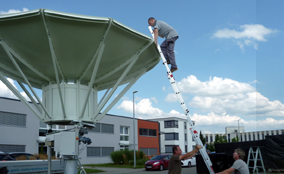
Designed for two-way VSAT communication or receive-only downlink applications, Super-HMAM accommodates satellite transmission antennas of up to 4.9 meters in diameter, compared with the 2.7 meter maximum antenna capacity of the standard HMAM. Integral to Super-HMAM is a newly developed support structure, which can survive the storm conditions experienced at high-altitude relay and transmission locations where wind speeds can exceed 200 kilometers per hour.
The Super-HMAM antenna control unit and associated motor-control electronics are contained in an IP65-rated weatherproof outdoor housing with a hinged front-access port secured by dual key screws. An emergency cut-off switch is easily accessible. Above the housing is a resolver which is used to measure the azimuth angle of the antenna. An identical second resolver allows constant monitoring of antenna elevation. Azimuth and elevation drive motors each operate through a reduction gear.
All models in the HMAM range provide full motorized control of the x and y axes as well as transmission beam polarity. Like the standard HMAM, Super-HMAM can be controlled remotely via an IP link from a PC running a graphic user interface.
Super-HMAM was promoted strongly during the mid-September International Broadcasting Convention (IBC) in Amsterdam as a new addition to the Hiltron product catalogue. The company invited existing and potential customers to an inaugural Septemberfest at its stand on the Saturday evening of the show. This event received good support, and positive feedback indicates it will be an annual event.
Hiltron ComSys Core (HCS)
Another major development in product terms, Hiltron’s new generation ComSys Core (HCS) is an ultra-flexible controller with a variety of satellite Earth station control applications.
The HCS combines all the previously available Hiltron systems into a unified base system: ComSys-Core. Various modules are available to be integrated into a functional unit based on a 19-inch 2U equipped chassis with 16 module slots. (Also available is a half-rack-width 2U chassis equipped with 8 module slots). Both chassis come with an Ethernet interface for monitor and control via built in web-interface or SNMP protocol from a higher-level monitoring system.
Where redundancy in the transmitting chain of an Earth station is needed, regardless of whether it is a fixed antenna or a mobile one, Hiltron offers a standardized solution based on HCS. This system includes a waveguide switcher with or without phase combiner and the related control unit. The waveguide switcher can be integrated into the antenna hub, mounted at the antenna mount, integrated into an indoor rack, or fixed to the roof of a truck such as an SNG vehicle.

The control unit is equipped with modules for high power amplifier communication, waveguide switch interface and L-band switching. This combination integrates switches and control software for manual and automatic switchover which can be triggered by several signals coming from other modules within the HCS or from other HCS connected
by Ethernet. As many as two 2:1 or four 1:1 LNB redundant systems can be realized using the 16 slot HCS. The HCS can optionally be equipped with a 10 MHz GPS-stabilized reference source to feed the low noise block (LNB) downconverters.
For the LNB power supply, the company has developed a standardized solution based on the HCS. The LNB power supply shelves have dual redundant hot-swappable power supplies. Monitoring of LNB current and RF level is available for remote alerting when threshold levels set by the operator are exceeded. The LNB power supply shelves are available in three configurations:
• 24 port LNB power supply as 19 inch 2U shelf
• 24 port LNB power supply for cabinet mounting
• 10 port LNB power supply for cabinet mounting
As an option, the HCS can be provided with a GPS synchronized 10 MHz reference oscillator module. This module distributes the reference via HCS-bus to the LNB supply modules and has three additional SMA reference outputs with switchable output level.
TV 2 Norway
For TV 2, Norway’s largest commercial television broadcaster, Hiltron recently completed a major teleport relocation project. The teleport is situated on the roof of the new MediaCity Bergen complex (see image above) and will provide wide-ranging satellite connectivity for content ingestion, forwarding and transmission, as well as communication with digital newsgathering vehicles and mobile production trucks. The firm’s role was to integrate a large communication system including seven satellite antennas as well as control processors, signal distribution and optical fiber cabling. Pre-assembly took place at the Hiltron factory during June and July.
Uzbekistan DVB-T2 Broadcast Distribution Project
For the Republic of Uzbekistan, the company is working on a major satellite-based broadcast distribution project. The new system will be used for the distribution of television and radio programs to regional DVB-T2 terrestrial digital broadcast stations across the country. Included in the system will be RF transmission equipment, monitoring and control for a 6.3 meter satellite uplink antenna and 120 downlink antennas with accessories for regional reception stations. The RF transmission configuration consists of a 1:1 redundant DVB-T2 modulator and a waveguide system with 1:1 redundant 100 watt compact outdoor Ku-Band (13.75 to 14.5 GHz) solid-state power amplifiers with integrated block upconverters.
Two integrated receivers, one stream analyzers and an optional spectrum analyzer are provided for feedback transmission control. Transmission control is via a Hiltron Monitoring and Control System (HMCS). In addition, 120 satellite TVRO systems have been delivered. Each consists of a 1.8 meter antenna dish and offset feed horn with an azimuth/elevation and polarization mount, fully equipped with Ku-band low-noise block downconverters and L-band cabling.
DSNG Projects
DSNG vehicle projects for three major Germany broadcast networks were completed during 2017. The largest of these included a complete satellite communication system and a 1.8 meter Ku-band high precision carbon-fiber roof antenna. The electronics are comprised of two solid state power amplifiers, Hiltron HSC4 communications control, a Hiltron HACU antenna controller, Hiltron HMCS monitoring system and a 16 x 16 ETL switching matrix.
Systems and Projects Manager
Last, but not least, on the personnel front, Hiltron expanded with the appointment of Thorsten Peters to manage the systems and projects departments. He joined us from Media Broadcast GmbH where he was engaged in technical and financial management roles.
Jan Molter is the Managing Director of Hiltron Communications. Additional information regarding the company may be obtained at
www.hiltron.de/
ICEYE—Smallsat SAR Imaging Expertise
By Pekka Laurila, Chief Financial Officer and Co-Founder, ICEYE
In the realm of Earth Observation (EO), the radar imaging market is still massively underserved.

While optical satellite data of the planet is increasingly more available, radar imaging is still not yet where it needs to be. However, demonstrable key steps have been made in satellite radar technology over the last year that gives ICEYE confidence that 2018 will be a milestone year for the industry and for the company.
With darkness or clouds covering two-thirds of the planet at any given time, Synthetic-Aperture Radar (SAR) technology delivers reliable imaging where optical imaging falls short. ICEYE has developed a unique SAR sensor to offer imaging services anywhere around the globe, anytime, with response times measured in a few hours. By enabling economically viable microsatellite constellations, ICEYE is delivering expanded access to SAR data at a cost and time efficiency that has never before been available to commercial and government entities.
Which industries will benefit most from access to ICEYE’s SAR data? As ICEYE is actively speaking with potential customers to understand their unique needs, the company has seen immediate potential for early adopters in industries such as maritime, agriculture, insurance and finance.
It’s clear that 2018 will be a groundbreaking year for determining which industries will use new SAR data sources first and how they will apply that information to making business decisions. As the “New Space” revolution is making space more accessible, previous quality and quantity limitations of accessible data are rapidly being broken. Once data availability matches demand, the key for SAR data users is in how applying the new data being acquired at an unprecedented scale can be utilized and applied most effectively for business.
Initial Maritime Uses for ICEYE’s SAR data
The maritime industry is especially in ICEYE’s focus as an extension of 2017’s technological developments. There are already many customers using SAR data in that realm, hungry for new data sources, and this is where 2017’s solutions come into play in 2018.
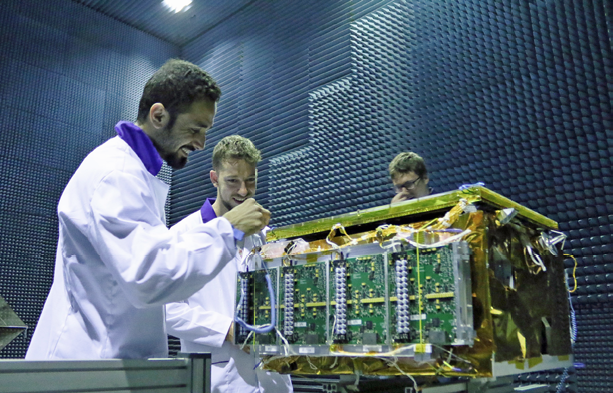
Anechoic chamber testing. Photo is courtesy of ICEYE.
Just like in many other industries, there are times when EO customers can make a choice between optical and radar data. For maritime uses, the main benefits of choosing SAR satellite data rather than optical are many.
First, the reliability of being able to gather radar data through clouds and darkness is a massive advantage and enables imaging when optical fails. Additionally, when imaging areas in the sea environment, the high contrast between water and other elements on the surface of the water, such as vessels and oil, is quite distinct and helps in discerning information from the raw data.
Sea ice monitoring, sea state monitoring for shipping routes, iceberg tracking, ocean current detection for shipping routes, port container yard fill rate and construction monitoring, oil spill monitoring and crude oil seep discovery, and many more uses for this data already exist. ICEYE has been actively working within the organization and with partners to further develop the data capabilities in these use cases for maritime. The company is happy with the developments, and is confident that furthering the access to SAR data will enable additional use cases beyond what is available today.
The “New Space” Revolution
The idea of a “New Space” approach ultimately means that newer, more agile and innovative entrants, like ICEYE, are taking on more calculated risks in technology development.
Often times, the results are massive leaps in the speed of production and rapid advancements of key technologies. For ICEYE, this meant disruption of the aerospace industry’s long-held belief that SAR technology is only possible using traditional, massively large satellites at higher costs. Over the last year, ICEYE has flipped those beliefs on their head, mastering a New Space driven hardware and software development cycle and pushing the envelope, especially in the field of miniature RF instruments.
ICEYE has officially changed the model for SAR technology by delivering premier radar imaging quality from smaller satellites that can be launched by the dozens. The size of ICEYE’s satellites and the calculated production process allows them to provide a much faster and higher capacity offering than more traditional aerospace companies in the past — not to mention the improvement in cost for the customer. ICEYE is able to offer access to the company’s microsatellites at much lower costs than larger satellite providers who price out customers with their launch costs alone.
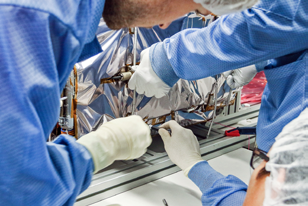
Through the use of increasingly more affordable launch providers, ICEYE is able to launch full constellations of SAR microsatellites more efficiently and cost effectively. This, in turn, enables imaging of individual locations anywhere on the globe within a matter of hours, rather than days, weeks or even months. More importantly, ICEYE’s new space approach allows the company to mass-produce SAR satellites at an unforeseen rate, completing individual models in a matter of months rather than in years.
Aerial Imaging and Partnerships
ICEYE completed four, separate, aerial SAR imaging campaigns throughout 2017, delivering data to customers and further developing the company’s instrumentation. This step has been crucial in hardware and software cycles and has afforded the company a strong footing before heading to orbit.
During these campaigns ICEYE has imaged, processed and delivered data to multiple partners, and has taken many steps in maturing its commercial operations and technical compatibility with the users as a result.
In 2017, ICEYE finalized significant partnerships with future customer industries and established aerospace organizations. This includes a vast network of ground station operators, established satellite data companies and other New Space hardware companies.
In anticipation of future progress, and based on demonstrated data service deliveries, ICEYE is moving toward a more open information flow with the public. The company will continue to focus on delivery prior to speculation. More information on the company’s developments can be expected during 2018.
First Satellites into Orbit
ICEYE’s ultimate goal is to massively expand access to reliable and timely Earth observation data.
The company’s recent 2017 additional funding of more than $14 million moves ICEYE even closer to achieving their goal. More importantly, as 2017 comes to a close, ICEYE is shipping its first satellite, ICEYE X1, for launch. This will be the world’s first SAR instrument that has been miniaturized to a satellite under 100 kg. (220 pounds). The ICEYE X1 will be providing data to select commercial customers shortly after launch.
The excitement within the company is tremendous and represents a major milestone in ICEYE’s journey to mastering the SAR constellation market and delivering on the firm’s mission.
ICEYE is also looking forward to kicking off their commercial radar data services by launching the first three of the company’s satellites into orbit before the end of next year.
Author Pekka Laurila is the Chief Financial Officer and Co-Founder of ICEYE. To learn more about the company, please visit www.iceye.com/.


